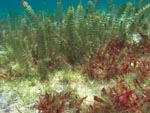Aquatic plants indicate lake condition

Aquatic plants are valuable indicators of lake health, and through LakeSPI – a new management tool using ‘Submerged Plant Indicators’ (SPI) – they can be used to assess lake condition. LakeSPI is based on the principle that a lake can be characterised by the composition and depth of its native and invasive plants and that changes in a lake will be reflected by changes in the composition of the aquatic vegetation.
Aquatic plants are good indicators of lake condition as they are easy to observe, reflect the environmental conditions in a lake over an extended period of time, and bring a focus to the littoral margins where greatest public interaction and perception occur.
Few lakes in New Zealand retain their original native vegetation, and the condition of many lakes is threatened by land-use changes and invasions of alien aquatic plants. LakeSPI enables lake managers to assess lake condition and monitor trends in lake condition over time, provides relevant information for regional and national reporting requirements, and can be used to help assess the effectiveness of catchment and lake management initiatives.
LakeSPI is freely available to lake managers and other interested parties as a user manual and a technical report (www.niwa.co.nz/ncwr/lakespi/). For more details on submerged plants or the LakeSPI method, visit the aquatic plants section of this website (www.niwa.co.nz/rc/prog/aquaticplants/news).
John Clayton [ [email protected] ] Tracey Edwards [ [email protected] ]
